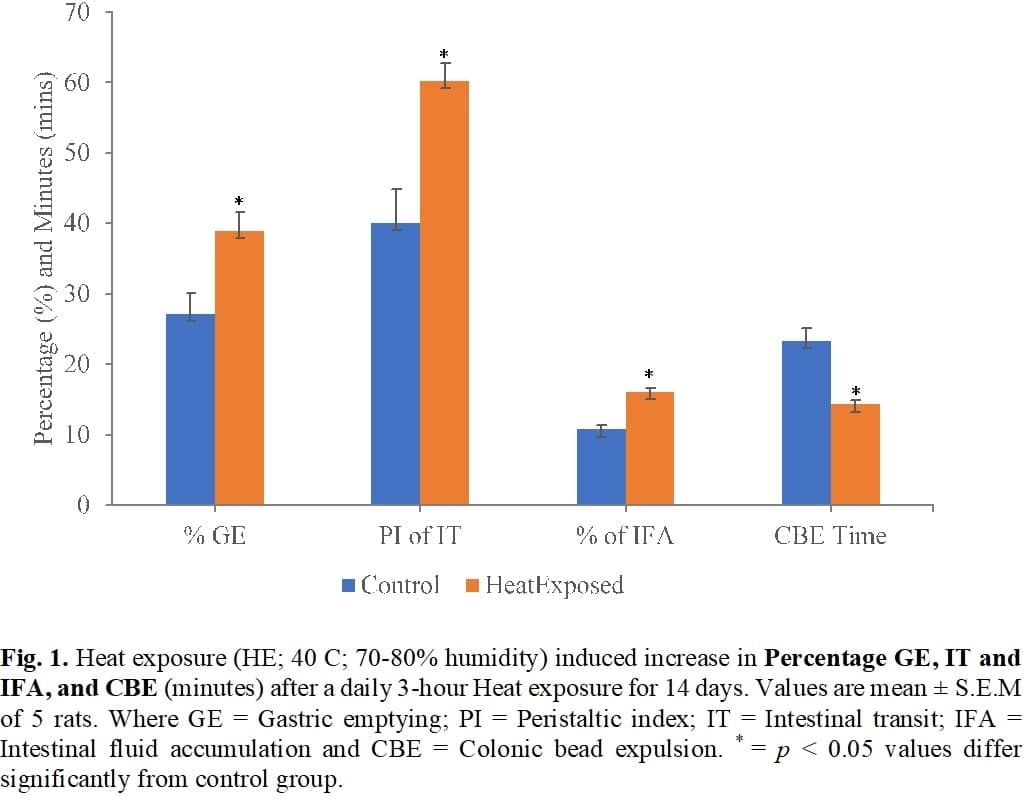Global warming is currently a major challenge facing living and non-living things in the tropics and subtropics. The gastrointestinal (GI) tract is particularly sensitive to stressors including hyperthermia. Our study therefore, aimed at examining how gastrointestinal motility can respond to sub-chronic heat exposure (HE) stress in Wistar rats. Rats (male, 110-130 g, n=5) were randomly assigned to two groups; Control in a normal room temperature at 30°C and 70-80% humidity, and a HE exposed to heat at 40°C and 70-80% humidity 3 hours daily for 14 days in a thermal controlled room. Rectal temperatures (RT) were taken daily, before and immediately after HE with a mercury thermometer. After 14 days, rats were 18-hour fasted prior GI motility experimental procedures. Gastric emptying (GE), intestinal transit (IT) and intestinal fluid accumulation (IFA) were assessed by the methods of Droppleman et al., 1980, Suchitra et al., 2003, Sisay et al., 2017 respectively. Colonic motility was also, assessed by colonic bead expulsion (CBE) time, Camilleri and Linden, 2016. Values are means ± S.E.M., compared by t-test and ANOVA, as applicable to data. Our HE resulted in hyperthermia as evidenced by increased post-exposure RT; compared to control, RT in HE rats increased throughout the HE periods (e.g. Control: 35.30±0.06 vs. HE: 38.54±0.07°C Day 1, P < 0.05). GE (Control: 40.03±4.78 vs. HE: 38.92±2.74 %, P < 0.05) and IT (Control: 27.19±2.90 vs. HE: 60.17±2.58 %, P < 0.05) was increased. Also, IFA was increased (Control: 10.73±0.60 vs. HE: 16.07±0.54 %, P < 0.05) while CBE time was decreased in the HE rats (Control: 23.24±1.89 vs. HE: 14.28±0.66 minutes, P < 0.05). These data indicate that sub-chronic HE increased GI motility and intestinal fluid accumulation as evidenced by an increased ST and RT, GE, IT, IFA and decreased CBE time.
Extreme Environmental Physiology (University of Portsmouth, UK) (2019) Proc Physiol Soc 44, C40
Oral Communications: Heat exposure stress alters gastrointestinal motility and intestinal fluid accumulation in Wistar rats
A. Adegoke1, W. Owonikoko1, K. Ajeigbe1
1. Department of Physiology, Igbinedion University, Okada, Edo State, Nigeria.
View other abstracts by:
Where applicable, experiments conform with Society ethical requirements.


